Visit Barcelona for its Famous Art and Architecture
- Pinterest1.1K
- Facebook32
- Twitter3
- Reddit0
- Flipboard1
- Email1
- Buffer19
- 1.2Kshares
- Like
- Digg
- Del
- Tumblr
- VKontakte
- Buffer
- Love This
- Odnoklassniki
- Meneame
- Blogger
- Amazon
- Yahoo Mail
- Gmail
- AOL
- Newsvine
- HackerNews
- Evernote
- MySpace
- Mail.ru
- Viadeo
- Line
- Comments
- Yummly
- SMS
- Viber
- Telegram
- Subscribe
- Skype
- Facebook Messenger
- Kakao
- LiveJournal
- Yammer
- Edgar
- Fintel
- Mix
- Instapaper
- Copy Link

Visit Barcelona for its visual attractions! The inspiring architecture by Gaudi, and 3 world-class art museums of 3 famous artists: Picasso, Dali & Miro.
A trip to Barcelona will always include visiting many of its interesting architectural sights. After all, this is where you find most of the famous buildings by the architect Antoni Gaudí. Everybody should see the inspiring interior of the Sagrada Familia Cathedral once…
On the other hand, the vibe of the city has attracted a number of now world famous artists, like Picasso, Dalí, and Miró. To celebrate this, the city of Barcelona and the surrounding province of Catalonia present several very impressive collections of their art, in dedicated museums, in and around Barcelona.
We were short of time, and possibly stamina too. Therefore, we limited our sightseeing to the architecture and a bit of the art – our main interests in any city the size of Barcelona.
What you will find in this article:
How Modernisme Evolved, the Spanish ‘Art Nouveau’
Allow me to begin with a brief history. Modernisme (important: the Spanish style is spelled with an ‘e’ at the end!) and its opulence can be found in several art forms, not only architecture. In French speaking countries it was referred to as ‘Art Nouveau’. Modernista is a distinct style of Spanish architecture, thanks to Neo-Mudéjar influences, a fancy word for Moorish inspired buildings.
Nowadays, Gaudí is the most famous representative of this building style, but there are countless beautiful examples by less famous architects throughout the inner city and the precinct of Eixample.
So don’t rush from one sight to the next! Let your eyes wander up and down the facades of buildings that you pass along the way! You might be surprised by what you see. Wikipedia has a helpful list of the most outstanding Modernista Buildings in Barcelona Download it and keep it on your phone.
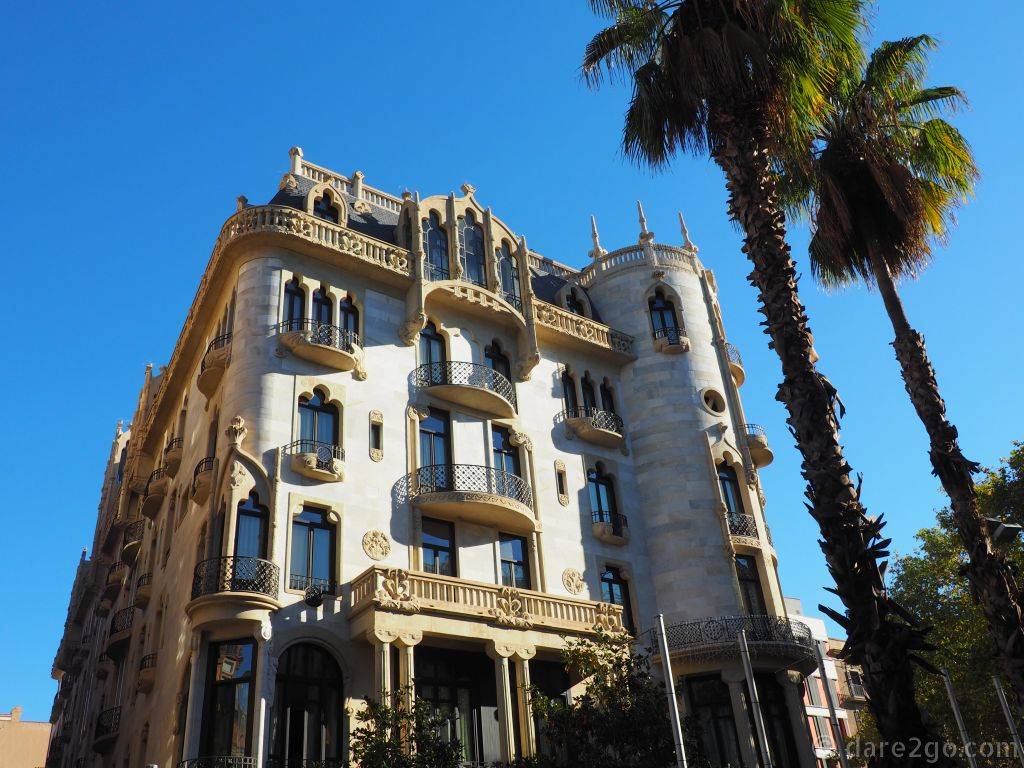
One of the many Modernista facades in Barcelona. There’s so much outstanding architecture, which wasn’t designed by Antoni Gaudí. This building stands on the Passeig de Gracia, further up the road from Casa Milà.
Several factors in the late 1800s contributed to the incredible density of these architectural gems throughout Barcelona.
- The old city was ‘bursting at its seams’ and urgently needed to expand. Finally officials decided to demolish the old citadel and town wall, which previously formed the inland boundary of the city.
- The new suburb of Eixample (Catalan for ‘expansion’) was planned, to the north of the Rambla. It’s grid pattern of streets and boulevards, which are of generous proportions, with the typical chamfered corners, is credited to the visionary design by Ildefons Cerdà.
- At the time, Barcelona was a flourishing city thanks to a new bourgeois class, who had made money in the new Americas and from the evolving Spanish textile industry. These ‘new rich’ had a desire to outperform each other, showing off their wealth with their opulently decorated new houses.
- The final spark, which started the fresh boom, was the 1888 Barcelona Universal Exposition [World Exhibition]. For this, the site of the just demolished citadel was transformed into an exhibition park, now the Ciutadella Park at the end of the Rambla. Most Catalan architects of any standing provided designs for this international showcase of Barcelona. This in turn inspired the new bourgeois to employ these masters afterwards, to design their own houses. A real building boom followed the end of the successful Barcelona Universal Exposition.
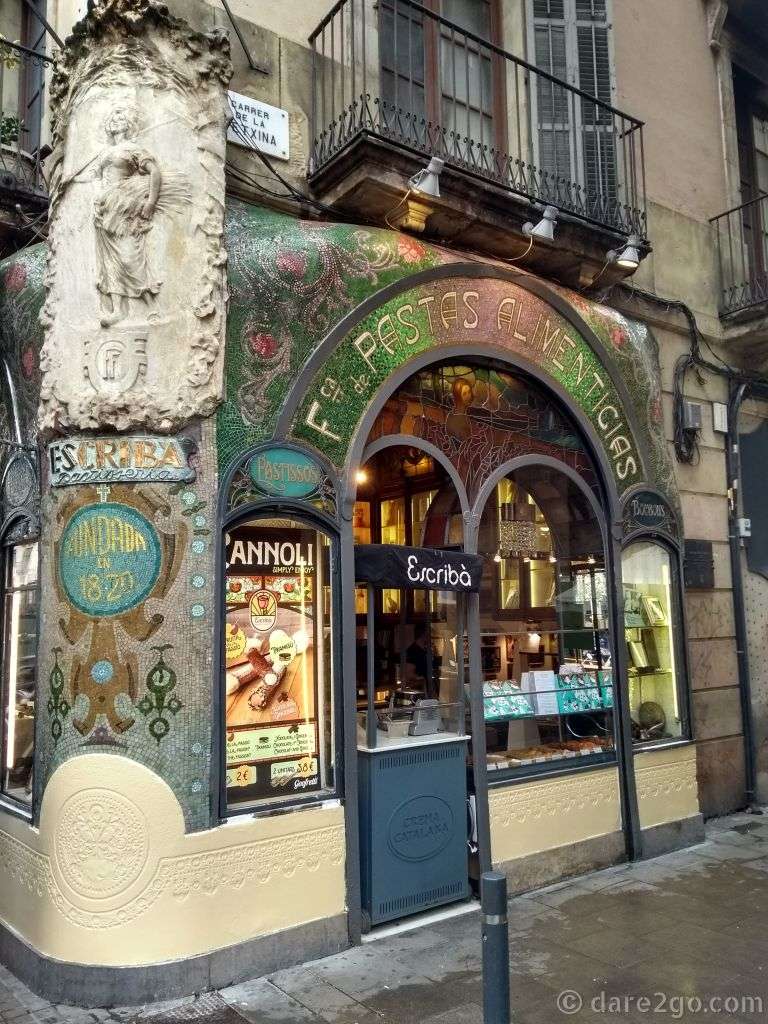
A beautiful Art Nouveau facade along the Rambla of Barcelona. The Patisserie Escriba is actually worth a visit!
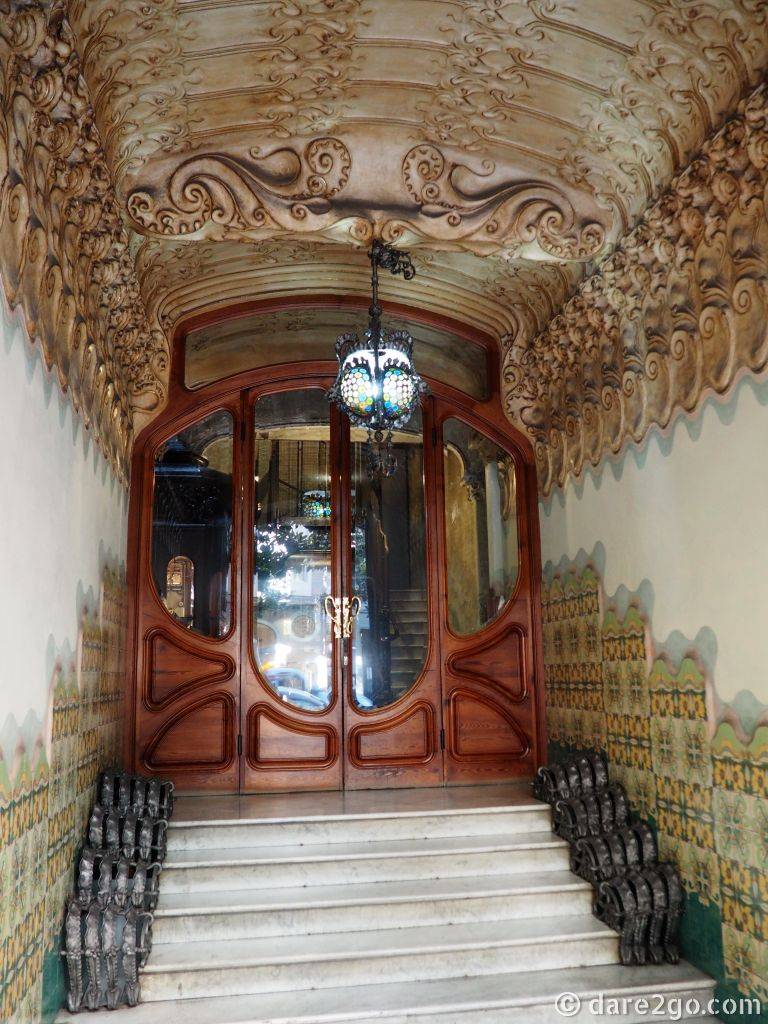
Just one of the many splendid entrances in Barcelona. I photographed this because it shows how closely the Modernista architecture is related to Art Nouveau (and because I liked it).
Foremost Barcelona is Famous for its Gaudi Buildings
From the outset, it was clear to us that Gaudi’s architecture was the main thing to see in Barcelona. So that’s what we concentrated on for our visit. But apart from reading a couple of articles beforehand, and seeing many photos of Gaudi buildings, we had little knowledge about his specific style or his significance in 20th century architecture. The only other fact we were aware of is that UNESCO included the architecture of Gaudí in Barcelona in its World Heritage List. The World Heritage list is always an additional guide for our travels.
Gaudí’s work exhibits an important interchange of values, closely associated with the cultural and artistic currents of his time, as represented in el Modernisme of Catalonia. It anticipated and influenced many of the forms and techniques that were relevant to the development of modern construction in the 20th century. – from the UNESCO World Heritage Listing “Gaudi in Barcelona”
If you’re in a similar situation (that you don’t know much about Gaudi’s style of work), we highly recommend that you start your Gaudi tour of Barcelona at one of his later buildings, as we did. Why? Because there you will find an interesting exhibition of some of the materials and ideas, which inspired him throughout his life, and gave him clues on how to execute his complex designs. Just enough to understand his work, not too much to suffer ‘information overload’. If possible, we recommend spending at least 2-3 hours at our first stop:
Casa Milà or “La Pedrera”
Casa Milà was the last residential house designed by Gaudí, before he dedicated the rest of his life to the construction of the cathedral of Sagrada Familia. Everything he had learned up to then, flowed into this design.

The organic facade of Gaudi’s Casa Milà in the sunlight of an early Winter afternoon.
The entire structure is held up by a number of large support pillars, a full eight stories high. This gave him the freedom to forego any straight walls in the entire building, as none were required for structural support.
On your visit, the first location the audio guide will take you is the roof, with its twisted and tiled chimney structures. Not all of these are chimneys; some are ventilation shafts, others the top of stairwells.
From there the tour continues down into the attic – and that’s the place you should allow some time for! The attic structure itself is already rather interesting, as the complete roof support is made from a fishbone like pattern of bricked arches – not wooden beams!
But the displays in this attic are what really makes it worthwhile spending time here. Many of them explain very clearly where Gaudí found his inspiration, like the structure of feathers of birds, or veins in plants.
One particular display looks very simple but can be a real eye-opener, if you study it closely and read the attached signage! It’s a group of chains hanging from the ceiling with a mirror below. Gaudí used the same set-up to find the correct angles for his amazing curved roof structures. The chains will always hang in the way that natural gravity force guides them. The mirror then provides the upright view of the resulting structure. He designed the entire column placement of the cathedral using a complex chain model. This is called a ‘Catenary Model’ [link to explanation].

The Catenary Model used by Gaudi to work out the angle of his support columns – like those in the Sagrada Familia cathedral. There’s a mirror below which provides the an upright view of the hanging chains. [photo credit ]
After you have seen all of the attic, you will be guided to one of the apartments, still partly furnished with period pieces. It’s extremely interesting to see the flow of rooms, their very sensible arrangement and exposure to natural light. This was achieved by Gaudi’s plan to forego straight walls, and the resulting rectangular floorplan.
Please click thumbnails below for a larger photo with description.
- Gaudi’s variously shaped chimneys and stairway tops on the roof of Casa Milà.
- A wire model of the Sagrada Familia in the exhibition space of Casa Milà. The exhibits in the attic show very well where Gaudi drew his inspiration from, and how he designed the statics of many of his buildings. Well worth spending some time here!
- You will also find some furniture Gaudi designed for his clients, on the attic floor of Casa Milà. These chairs looked extremely comfortable in their organic shapes. From an attached label we learned that for some shapes, like the ends of armrests, Gaudi used play dough, which he shaped in his hands until the shape felt right. This was then transformed into the wood design.
- The organic facade of Gaudi’s Casa Milà continues inside to the courtyard. Here it’s all painted in earthy tones and patterns.
During peak season we highly recommend booking your tickets in advance to avoid waiting in line at Casa Milà!
Address of Casa Milà: Passeig de Gràcia 92 in the suburb of Eixample
A visit to Casa Milà should certainly leave you with a better understanding of Gaudi’s sense of space, his drive to find unconventional solutions, and his genius in achieving beautiful and inspiring environments, which function well, day in, day out.
Now follow us to some of Gaudi’s other architectural masterpieces in Barcelona!
The Cathedral Sagrada Familia
Once he was approved to continue the building of the Sagrada Familia Cathedral, Gaudí basically removed himself from all other work and dedicated the rest of his life to this enormous project. Reportedly, he lived his final years on site!

Looking up at the ceiling inside Sagrada Familia. A dazzling sight, with all the different shapes pointing upwards. [photo credit ]
Personally, I would allow at least 2-3 hours to visit this stunning cathedral, plus time to stand in line at the security check. If it’s busy, maybe add an extra half hour because you might be surrounded by groups of tourists, unable to move as you wish. But don’t let this discourage you from visiting the “Basílica y Templo Expiatorio de la Sagrada Familia” (full name in Spanish). We found it a very uplifting experience.
The entire construction is financed by donations (and today by your entrance fees, so don’t flinch if these are a little bit high). The Spanish Civil War under the Franco Regime interrupted work for years. During this war, part of the the already finished crypt was destroyed, as were many of Gaudi’s original drawings and plaster models. It took over 16 years to piece things back together…
Please click thumbnails below for a larger photo with description.
- The two main towers of the Sagrada Familia cathedral are still under construction. Once fully erected, they will be the tallest church towers in the world.
- Just a small section of the elaborate stone work on the nativity facade of the Sagrada Familia cathedral in Barcelona. These stone carvings were all designed by Antoni Gaudí. According to many reports, he worked on them himself.
- The sacristy inside Sagrada Familia was destroyed during the civil war in Spain. At the time, these furnishings held many of Gaudi’s sketches and plans. A lot had to be reconstructed, which took over 16 years. (The inserted information panel explains a bit more. Watch the video when you are visiting!)
- Part of the light-flooded, airy inside of the Sagrada Familia in Barcelona.
Tickets for the Sagrada Familia Cathedral should be bought in advance! They can be sold out for days. Please don’t skimp; at least get an audio guide for better understanding. Either buy your tickets directly online, or join one of the “skip the lines” tours offered online.
Address of the Sagrada Familia Cathedral: Carrer de Mallorca 401 (it’s shown on every city map, so you can’t miss it).
Casa Batlló
In walking distance from Casa Milà you will find Casa Batlló on the opposite side of the boulevard. This is another of Gaudi’s masterpieces and part of the “Illa de la Discòrdia” – four very unusual buildings standing side-by-side (the other three are by different architects).

A close-up of the tiled facade of Casa Batlló, another one of Gaudi’s spectacular houses in Barcelona. This one is part of the “Block of Discord”. [photo credit ]
As with all other Gaudí buildings, we recommend booking your tickets in advance to avoid waiting in line at Casa Batlló!

The amazing tiling inside the Gaudi designed Casa Batlló – simply stunning! [photo credit ]
We didn’t visit the inside due to budget and time constraints. Casa Batlló is a private property, currently [2018-19] undergoing renovation, and a ticket price of €25 p.p. seemed a little high for that.
Address of Casa Batlló: Passeig de Gràcia 43
Casa Vicens
This is probably the one example, where you can see the Moorish influence for Modernista buildings very clearly. Just look at details of the facade. This house was built as a summer residence for one Manuel Vicens, who reportedly had financial interests in the ceramic factory Pujol i Bausis, which might explain the extensive use of tiles on the facade…

The colourfully tiled facade of Casa Vicens, Gaudi’s first house design in Barcelona. It clearly shows the Moorish influence, called “Neo-Mudéjar” in Modernista architecture.
But Casa Vicens stands out for several other reasons:
- it was Gaudi’s first commission for a residential building
- it is considered the first ‘Modernisme’ building in Barcelona
- it is an outstanding example of Neo-Mudéjar (Moorish) influences
- its colourful tile facade really brightens up the street scape
For current entry times and prices check the website .
We only saw the outside because, due to our pre-booked time slot at Casa Mila, we were a little short on time to visit the inside.
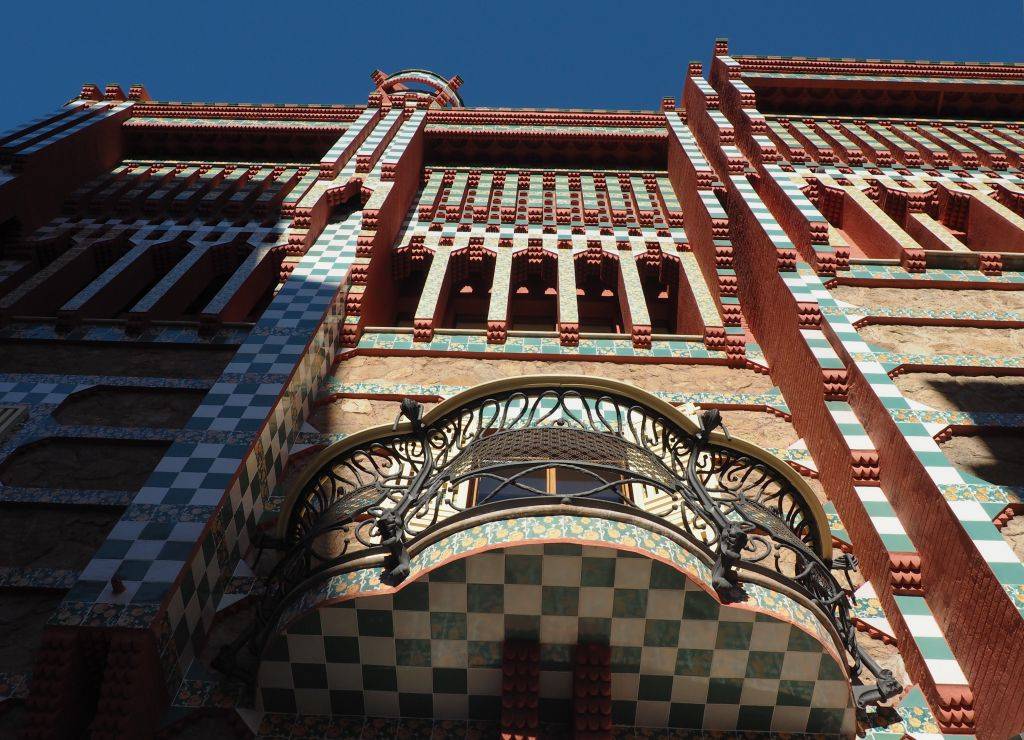
A close-up of the tiled facade of Casa Vicens, the first house Gaudi designed in Barcelona.
Address of Casa Vicens: Carrer de les Carolines 20-26 in the Gràcia neighbourhood
Palau Guell
You will notice the recurrence of the name Güell in projects designed by Gaudí. That’s because Eusebi Güell was a friend of Gaudí, one who gave him numerous commissions in different locations. We’ll come to others further down.
Palau Guell was built, between 1886 and 1888, as palatial city residence for the Güell family. It’s located near the old centre of Barcelona, just off the Rambla. Its heavy and plain facade is rather atypical for Gaudí designs, but it fits into the surroundings. It’s also included in the World Heritage listed sites for Gaudí architecture.

The fairly plain, heavy looking facade of the Palau Guell residence Gaudi designed.
From what I have read since, the inside is a completely different story. There Gaudí introduced many opulent design features, for which he’s famous. Unfortunately, we arrived ill-informed on a Monday, and found the Palau Guell closed.
You can visit Palau Guell any day of the week except Mondays (so don’t arrive as badly informed as we were!). For opening hours and current admission prices, see their website , which also contains additional information about the house and its construction.

The richly decorated inside of Palau Guell, which Gaudi designed for Eusebi Guell, almost belies the rather simple facade of this residence. [photo credit ]
Address of Palau Guell: Carrer Nou de la Rambla, 3-5, 08001 Barcelona
Park Guell
On the hill overlooking the city, is another tourist attraction designed by Antoni Gaudí: the Parc Güell – yet another commission by his close friend. Güell had the idea to turn these wooded hills into a community of the well off Barcelonés. To make the land more attractive he asked Gaudí to design the environment. For example, today’s prominent colonnaded hall was initially thought as a communal market place.
Construction of the park took more than 15 years, and was never really finished because the land didn’t attract enough buyers. To this day, there are only 3 houses dotted on the hills behind, one of which used to be Gaudi’s private residence until he moved to the Sagrada cathedral. Now it houses the Gaudi House Museum .

A lovely, sunny afternoon at Parc Guell – with no sign of construction work… [photo credit ]
We planned to visit the park on our way out of town, as it was more or less ‘en route’ to the south. First, it proved difficult to find parking for our camper, then we discovered that the main section, with colonnaded hall, is currently undergoing extensive restoration works. These should be finished by late 2019, but judging by the progress we witnessed in November 2018, we would assume that work might continue into 2020.
I wasn’t feeling too well, with hip pain from too much walking in previous days, so we decided to forego entry into the restricted (and paid) area of the park. Instead we walked around its outer perimeter, which provides good views of the complex and the buildings, with the city skyline as a backdrop. It also brings you past the entrance of the Gaudi House Museum if you want to visit it. Until work is finished, this might be a cheaper and less crowded way to see a part of Parc Güell.
If you want to visit in peak season, it’s advisable to book your tickets for the restricted area ahead. The late afternoon seems to be a particularly popular time. You can use this option to book a ‘Skip the Line’ ticket for Parc Güell .

The state of Parc Güell when we visited in late November 2018. By then, the restoration work was supposed to be finished – we guess it’ll take another year. Can you see how most of the public access is restricted, both on top and below?

Casa Gaudi, inside the Parc Guell. This is another museum dedicated to Gaudi’s life and work; it belongs to the Sagrada Familia foundation.
Address of Parc Güell: Carrer d’Olot, 08024 Barcelona
Colonia Guell
If you can spare the time, Colònia Güell, just outside Barcelona, is well worth a visit. This is another project commissioned by Gaudi’s friend, which is also included in the UNESCO World Heritage Listing. In 1890, social unrest motivated Eusebi Güell to move his textile mill to Santa Coloma de Cervelló. He purpose-built an industrial village with amenities which would improve the workers’ quality of life: terraced houses, an athenaeum, theatre, school, shops, gardens and a church.
For us, this village was even more interesting because its concept is a very similar to Saltaire , a textile mill town in Yorkshire, England, which I was writing about at the time.

Not a Gaudi design, but the Ca L’Ordal is one of the impressive Modernista buildings in Colonia Güell.
Unfortunately, Güell’s businesses took a turn for the worse, and work at the Colonia was halted in 1914 (together with Parc Güell, see above). What you find today, alongside the town’s noteworthy houses and public buildings , is Gaudi’s Crypt.
The crypt is the only part of the planned church, which was ever finished. It marks a significant step for Antoni Gaudí, as it was here that he experimented with ideas and static solutions, on a smaller scale, that he would later apply to the much larger Sagrada Familia cathedral.

The inside of the crypt in Colonia Güell. Here, Gaudi experimented with many of his static ideas that he later used for the Sagrada Familia cathedral. You can see the similarities, on a much smaller scale.
Certainly the easiest way to get to Colonia Güell from Barcelona is with a tour.
Address of Colonia Güell: Carrer Claudi Güell, 6, 08690 Santa Coloma de Cervelló
La Cascada del Parque de la Ciutadela
You will come past this place in Barcelona a few times: the large Ciutadela Park at the end of the Rambla. The Barcelona Tourist Information (see our review below) is located here and the Hop-on-Hop-off bus goes around it. Here is Gaudi’s earliest work: he was partly involved in the design of the Cascada (waterfall, the large fountain in the park). Though his role was minor, as he was still studying at the time.

The large fountain in Barcelona’s central Ciutadella Park. Gaudi had a minor involvement in the design of this fountain. [photo credit ]
Modern and Abstract Art in and around Barcelona
Many well-known artists are or were attracted by the cosmopolitan vibe of Barcelona; and by the well-filled purses of the new bourgeois Barcelonés too, I’m sure. Three world famous names stand out: Pablo Picasso, Salvador Dalí, Joan Miró. None of them lived in Barcelona very long, but all three left their mark.
The Extensive Art Collection of the Picasso Museum in Barcelona
Though he wasn’t born in Barcelona (he was born in Malaga in Andalusia) and lived most of his life in France, it was Pablo Picasso himself who suggested the city of Barcelona as a suitable place for a museum dedicated to his work. Thus, it’s here that you will find the biggest collection of Picasso works on permanent display. A large amount of Picasso’s drawings and paintings were continually contributed by the artist himself, the last in 1970. Today, the exhibition occupies 5 adjoining buildings – an architectural experience as well.
Now, we have to confess, we didn’t visit the Museu Picasso. We had neither the time, nor the energy. But for any Picasso afficionado, a visit is a must if you are in Barcelona. Best book your tickets in advance , or make use of the free visiting times after 6pm on Thursdays and on the first Sunday of each month.

Inside the Picasso Museum in Barcelona. [photo credit ]
Address of the Museo Picasso: Carrer Montcada, 15-23 – 08003 Barcelona
Don’t Miss the Salvador Dali Museum in Figueres
If you are interested in Spain’s famous surrealist, Salvador Dalí, you must travel a bit north from the city – to Figueres. This small provincial town, the birthplace of Dalí, is around 140 kilometres from Barcelona. Commonly known as Dali Museum it’s actually more. Dalí himself transformed the ruined shell of the town’s theatre into a ‘Gesamtkunstwerk’, which displays the largest collection of his work and ideas. [See Wikipedia for a definition of Gesamtkunstwerk .]
If you want to get into the right mind space upon arrival, don’t walk straight into the entrance of the Dali Theatre Museum! Instead, first walk around it and discover all the quirky little (and not so little) features that the master added to the building’s facade.

The outside of the Theatre Museum Dali in Figueres. The golden ‘blobs’ on the wall are supposed to be traditional bread loaves. On the roof, large eggs and gold painted statues. To the left, the large glass dome of the museum.
Once you enter the Dali Museum in Figueres, you will soon discover how cleverly Dalí used every available space to install his art creations; from large sculptures to tiny objects; from prints to 3D-compositions; wall paintings to room-size installations – the entire complex is filled to bursting capacity with ideas born from Dalí’s ever-creative, surrealistic mind. You will need sufficient time to take it all in, that’s for sure.
Or, as the master himself said:
I want my museum to be a single block, a labyrinth, a great surrealist object. It will be [a] totally theatrical museum. The people who come to see it will leave with the sensation of having had a theatrical dream. — Salvador Dalí
Please click thumbnails below for a larger photo with description.
- The ‘piece de resistance’ and crowd favorite at the Dali Museum: a black Cadillac with a large nude amazon statue on its bonnet. Look inside the car when you visit!
- A painted ceiling inside the Dali Theatre Museum in Figueres.
- A full room installation in the Dali Theatre Museum in Figueres. The blonde wig in the foreground is really small and frames the furnishings behind.
- Funnily enough: we saw the same bust by Salvatore Dali in Bogota at the Botero Museum .
How to get to the Dali Theatre Museum
You can take a direct train from Barcelona Sants station to Figueres. There are up to 15 connections per day and the journey lasts just under 1 hour. We visited the museum ‘en route’, coming from France in mid-November . At that time there was no need to buy tickets in advance. But if you plan to arrive by train, I would strongly recommend reserving your entry tickets in advance .
Address of the Dali Theatre Museum: Gala-Salvador Dalí Square, 5 – 17600 Figueres, Catalonia
See the Sculptures and Painted Art of Joan Miro
Joan Miró is the only one of my three featured artists who was actually born in Barcelona. After some time in Paris, he chose to live and work mostly on Mallorca, the picturesque Mediterranean island. He’s another surrealist artist from Catalonia, who became world famous – although he never wanted to be categorised as such.
Nowadays, Joan Miró might be best recognised for his ‘color field’ paintings and sculptures, most of them in clear primary colours – dominant red, yellow, and blue. But the Miro Museum in Barcelona will open your eyes to other styles this artist has mastered. Although, his bold minimalist style might not be everyone’s ‘cup of tea’…
The Fundació Joan Miró was founded by the artist himself, who contributed many works from his private collection. It’s located to the south, on a hill overlooking the city.

The outside of the Fundació Joan Miró with one of his monochrome contemporary sculptures in front. [photo credit ]
Regularly the Fundació can be reached by a furnicular from the city; currently [2019] this is not operational and you have to take a bus. For more please see the Fundació’s website .
You will find other works by the artist in numerous public places around Barcelona. The most prominent is a large mosaic in the middle of the Rambla. Barcelona Turisme has published a dedicated Miro Route for the city .

The colourful Joan Miro paving on the median strip of La Rambla in Barcelona. [photo credit ]
Address of the Miro Museum: Parc de Montjuïc – 08038 Barcelona
Our Tips for Visiting Barcelona
A visit to any city the size of Barcelona, with its abundance of interesting sights and experiences, requires planning ahead. We were running out of Schengen visa time and had to restrict our visit to a few highlights of Barcelona, which were of real interest to us.
Popular places in Europe, like Barcelona, don’t leave much room for spontaneous sightseeing either. To restrict the crowds, almost every famous landmark only sells a specific number of tickets for an exact time slot; once these are sold, you will be turned away. (This happened to us at the Alhambra in Granada, which was completely sold out from 2 days before Christmas into the first days of January the next year!)
We were lucky to visit Barcelona in late November, a reasonably ‘quiet time’. Even so, the lines at places like Sagrada Familia were fairly long. So don’t waste your time; either book tickets directly with the individual sights (we have provided the links in most cases), buy ‘skip the line’ tickets from online vendors, or join an organised tour to see the most important tourist sights.
Individual entry fees in Europe are not cheap, particularly for privately owned attractions (see my remark about Casa Batlló above). EU citizens can receive specific discounts. Bad luck if you’re from elsewhere and ask for a reduced entry fee, like a ‘pensioner’ ticket. So plan your expenses generously, or consider eliminating some of the more expensive attractions!
Barcelona Passes
I asked fellow travel bloggers; several replied that none of the Barcelona passes are really worth the money. When you research them online, be aware that many websites receive a commission for selling these passes – so their assessment can be a little ‘tainted’ by financial interests.

The confusing choice of discount passes in Barcelona. Now there’s a Gaudi Pass too.
Barcelona Tourist Information
We visited the main Barcelona Tourist Information at Ciutadella Park – it was a waste of time! We wanted to find information about pre-booking tickets and the comparison of the various passes. The office was absolutely understaffed and offered no seating for waiting customers. Selling seemed to be their main interest – not information. So after standing for over 20 minutes in line, while the only attendant was still selling things to one single customer, we left – no wiser than before. Shame on you, Barcelona!

Barcelona’s main Tourist Information at Ciutadela Park: for us a disappointing experience because the line at the only open counter didn’t move at all. We left with all questions unanswered after a 20 minute wait.
Conclusion
So our advice: research a Barcelona visit online beforehand! Pick the things you want to see, research the ticketing and pre-booking options for each sight, and go from there. Once you have this list you can check out the value of the above mentioned passes.
But remember: take it easy as the brain can only take in so much before things become a blur. Allow extra time to relax in a coffee shop, or for aimless wandering. You never know what you might discover that isn’t in any guidebook.
- beautiful parks and public places
- outdoor eateries and its famous ‘Tapas Bars’
- outstanding examples of public art
- other museums and art galleries, well worth a visit
- beautiful old-fashioned market halls to wander around in
- some of Europe’s best shopping
- sandy beaches of the Mediterranean, just outside its city centre
Our Tip: take a good guidebook to discover all that Barcelona has to offer a visitor!
If you plan your visit as a holiday, with time to relax, you can easily spend 10+ days in and around Barcelona. Personally, I would divide my time between the city and a nice beach side location…
Extra Tip for Gaudí Architecture
You can download an app for your smart phone about Gaudí and his works. This app is basically a series of short audio guides, accompanied by a few attractive photographs. The introduction provides interesting background information, and is an excellent preparation before you visit Gaudi’s buildings in Barcelona!
Download Gaudi BCN from Google Play | Apple iTunes
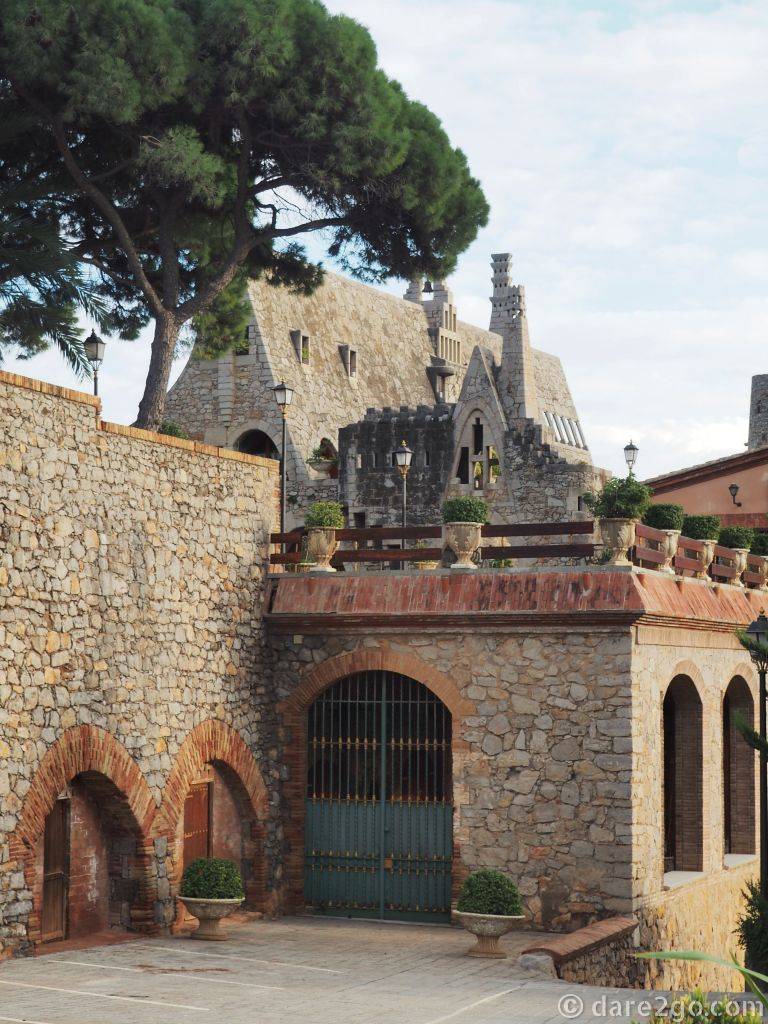
The “Gaudi Garraf”, built as a wine cellar, now a restaurant. This was designed for another of Güell’s businesses. Unfortunately the building is not generally opened to the public. (Address: Carretera de Barcelona a Santacreu de Calafell, C31, km 174, Garraf, Catalonia)
Extra Information for Campervans
Like many, we often rely on apps like Park4Night to search for overnight places in large cities. For Barcelona, we couldn’t find anything really inspiring within the city limits, so we stayed on a free parking lot in Badelona, just north of the city.
This parking is fairly small and only suitable for short(-ish) campers; with our 6.5 metres length we barely fitted. It’s located between the railway station and the beach. Overnight it was quiet enough; the trains seem to stop just after midnight.
It’s convenient to get into the city, with the train station just across the road. Usually a trip takes a little over 20 minutes to Ciutadella Park. Badelona is included in the city tariff zone.

Barcelona’s Plaça Reial is located just off the Rambla. It’s antique lamp posts, designed by Gaudi, are heritage protected.
Train & Subway Transport in Barcelona
It’s fairly cheap and easy to get around in Barcelona with the train and subway system. The trains are adequately clean and run very frequently. Only the morning and evening rush hours are really crowded.
We bought a 10 trip ticket, for only €10 [late 2018]. It’s good for travel on the integrated transport system including trains, subway and buses. On recommendation from the attending vendor in Badelona, we used this ticket for the two of us (he assured us that this is permitted). The first through the turnstile would pass the ticket to the next. You could do the same with a group of four or more…
Careful: the subway seems to attract some shady characters – as happens everywhere in the world! Somebody tried to pick Yasha’s pocket on a fairly crowded train.
Congratulations that you have made it this far through our long post about “Art & Architecture in Barcelona”. Thank you, it made it worthwhile writing so much ;)!
Have you visited Barcelona and seen the Gaudi architecture?
Did I get anything important totally wrong in my article?
Or did we miss any important Art & Architecture sight in Barcelona that you could recommend to our readers?
Please let us know in the comments below!
Now you have really reached the end. You might like to PIN this post for future reference or to share with your friends:



- Pinterest1.1K
- Facebook32
- Twitter3
- Reddit0
- Flipboard1
- Email1
- Buffer19
- 1.2Kshares
- Like
- Digg
- Del
- Tumblr
- VKontakte
- Buffer
- Love This
- Odnoklassniki
- Meneame
- Blogger
- Amazon
- Yahoo Mail
- Gmail
- AOL
- Newsvine
- HackerNews
- Evernote
- MySpace
- Mail.ru
- Viadeo
- Line
- Comments
- Yummly
- SMS
- Viber
- Telegram
- Subscribe
- Skype
- Facebook Messenger
- Kakao
- LiveJournal
- Yammer
- Edgar
- Fintel
- Mix
- Instapaper
- Copy Link


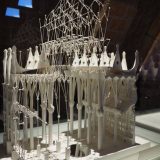
















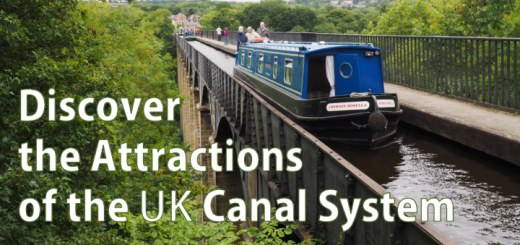


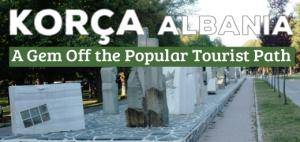






What a gorgeous blog post! Really something to bookmark for a future trip to Barcelona!
Thank you, Karin-Marijke. I warn you though: Barcelona get get really busy in peak season! It wouldn’t be your thing…
Barcelona comes to life through the photos you have taken, amazing. Interesting information on the famous buildings by the architect Antoni Gaudí. Wish I had this on my trip to Barcelona but will pin this for later use when I return.
For us it was most fascinating to learn about Gaudi’s style of architecture in Barcelona.
Barcelona is at the top of my wish list to travel to – I can’t wait to finally make it there!
Then my recommendation would be: go, but choose a time outside of peak season (and avoid October when it rains the most)! Or wait until 2026, the anniversary of Gaudi’s death. By then the Sagrada Familia is supposed to be completely finished.
You have put together a great collection of architectural styles in Barcelona. I was only in Barcelona for a short time so I concentrated mostly on Gaudi buildings. I did not see the range of buildings that you have photos of here. I do, however, love the Catenary styles that Gaudi and Moorish architecture use.
If you read carefully you will find that we didn’t had much time either and therefore had to restrict some visits to the outside only. I’d wish the Schengen Visa would give some option to stay longer – even if you would have to apply (and be approved) beforehand! I know we are not the only overland travellers struggling with the 90 days in all Schengen countries.
Barcelona is an amazing city! I highly recommend doing the day trip to Montserrat to see the monastery and hike.
Montserrat was one of the things we missed due to time restraints. We would have like to visit.